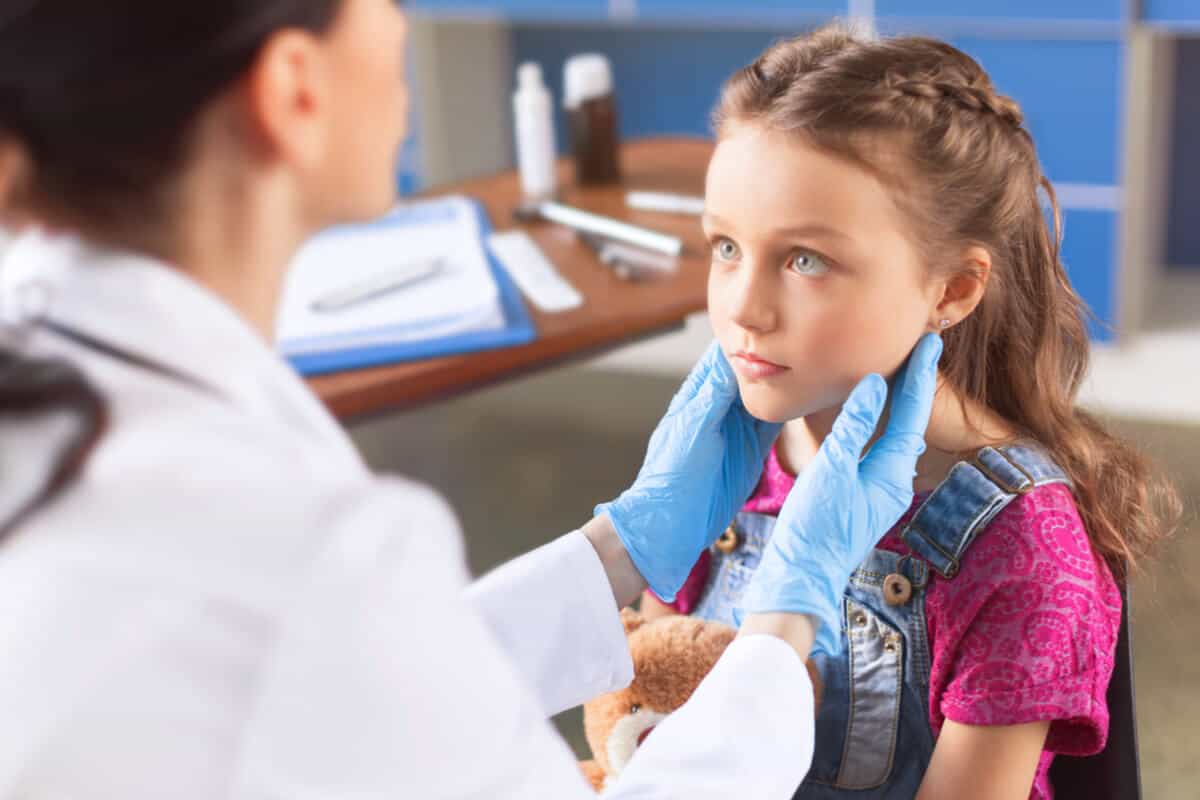What is the lymphatic system?
A key purpose of the lymphatic system is to orchestrate an immune response via lymphatic fluid that is transported in a one-way direction parallel to the blood vascular system, eventually returning the cleansed fluid to blood circulation. (7) This lymphatic transportation system utilizes lymph vessels that extend into every major part of the body except the brain and spinal cord. (8)
Lymph nodes advantageously reside in the abdomen, arms, chest, groin, legs, jaw, and neck.
Where are the lymph nodes and what do they do?
Lymph nodes filter out damaged cells, but they also produce and store lymphocytes and other immune system cells that attack and destroy harmful substances. As lymph is transported, it passes through one or more of the 500 to 600 lymph nodes located throughout the body where the foreign substances are filtered and neutralized via dendritic cells, macrophages, T cells, and B cells. (8)The number of lymph nodes varies by person, but the lymph node locations do not. Lymph nodes advantageously reside in the abdomen, arms, chest, groin, legs, jaw, and neck where they can efficiently receive the fluid that flows throughout the lymphatic system. (5)
Swollen lymph nodes
Enlarged lymph nodes indicate the immune system is hard at work. This can occur during a bacterial or viral attack, including the common cold and flu, mononucleosis, skin infections, sinus infections, and strep throat. When a bacterial or viral infection is not present, prolonged swollen lymph nodes can indicate lymphedema (obstruction or blockage), lymphadenitis (infected node), or metastasis (cancer that has spread). (5)Axillary lymph nodes are located in the armpit and specifically focus on fluid going to the breast, upper limbs, and upper back of the body. Because of their location and close connection to breast tissue, metastasis to the axillary lymph nodes can be predictive of survival outcomes in patients diagnosed with invasive breast cancer, indicating a worse prognosis. (12)
Natural lymphatic system support
An integrative approach to supporting lymph nodes and the lymphatic system, in general, includes integrative immune system support with diet, lifestyle, and dietary supplements. However, there are additional ways to specifically target the lymphatic system and lymph nodes.Acupuncture
Acupuncture has been shown to help encourage optimal lymphatic system drainage and can be an effective lymphedema therapy. A 2011 pilot study involving nine women with chronic lymphedema after breast cancer surgery found that acupuncture twice a week for a month resulted in a 30% reduction in the size of the affected arm. (3) A 2019 meta-analysis of six random clinical trials featuring 318 patients with cancer-related lymphedema showed that acupuncture was significantly more effective at reducing swelling compared to controls. (15)Medicinal herbs
From a herbal perspective, preliminary research demonstrates that horse chestnut (Aesculus hippocastanum) and butcher’s broom (Ruscus aculeatus) have been shown to specifically encourage optimal lymphatic drainage and may be a useful intervention for lymphedema. (14) Other immune-stimulating herbs, such as astragalus, echinacea, and ginseng, have been shown to specifically stimulate lymphocyte and dendritic cell activity as well as support organs of the lymphatic system such as the thymus and spleen. (2)(16)Yoga
Yoga can also be beneficial to the lymphatic system. Research indicates that yoga exercises combined with breathing exercises can improve fluid volume, range of motion, and pain associated with lymphedema. (9) A 2015 pilot study featuring 98 patients with severe leg lymphedema showed that yoga as a complementary therapy along with conventional treatment helped improve gait problems and significantly decreased fluid volume. (1)
Research indicates that yoga combined with breathing exercises can improve fluid volume, range of motion, and pain associated with lymphedema.
Lymphatic drainage massage
Manual lymphatic drainage massage techniques can also help keep lymph moving. (13) A 2018 clinical trial involving breast cancer survivors demonstrated that lymphatic drainage massage helped prevent the development of lymphedema. (10)Aromatherapy with essential oils
Essential oils also show promise. A 2019 systematic review of nine different human clinical trials showed that the fragrance of certain essential oils stimulated the immune system, specifically lymphocyte activity and other immune cells in the lymph nodes. The studies included in that review featured a variety of oils including citrus (e.g., lemon, grapefruit, and orange), lavender, marjoram, and sandalwood. (11)The bottom line
The lymphatic system and its lymph nodes are now getting the attention they deserve. When flowing smoothly and operating efficiently, this system can help the immune system effectively do its job. But when problems occur, it’s critical to use an integrative approach to support optimal lymphatic system function. This approach may include acupuncture, medicinal herbs, yoga, massage, and essential oils.- Aggithaya, M. G., Narahari, S. R., & Ryan, T. J. (2015). Yoga for correction of lymphedema’s impairment of gait as an adjunct to lymphatic drainage: A pilot observational study. International journal of yoga, 8(1), 54–61.
- Block, K. I., & Mead, M. N. (2003). Immune system effects of Echinacea, ginseng, and astragalus: a review. Integrative Cancer Therapies, 2(3), 247-267.
- Cassileth, B. R., Van Zee, K. J.,Yeung, K. S., Coleton, M. I., Cohen, S., Chan, Y. H., Vickers, A. J., Sjoberg,D. D., & Hudis, C. A. (2013). Acupuncture in the treatment of upper-limb lymphedema: results of a pilot study. Cancer, 119(13), 2455–2461.
- Choi, I., Lee, S., & Hong, Y. (2012). The new era of the lymphatic system: no longer secondary to the blood vascular system. Cold Spring Harb Perspect Med, 2(4).
- Douketis, J. D. (2019). Overview of the lymphatic system. Merck Manual, July. https://www.merckmanuals.com/home/heart-and-blood-vessel-disorders/lymphatic-disorders/overview-of-the-lymphatic-system
- Liao, S., & Padera, T. P. (2013). Lymphatic function and immune regulation in health and disease. Lymphatic Research and Biology, 11(3), 136-143.
- Margaris, K. N., & Black, R. A. (2012). Modelling the lymphatic system: challenges and opportunities. Journal of the Royal Society Interface, 9, 601-612.
- Moore, J. E., Jr, & Bertram, C. D. (2018). Lymphatic System Flows. Annual review of fluid mechanics, 50, 459–482.
- Narahari, S. R., Aggithaya, M. G., Thernoe, L., Bose, K. S., & Ryan, T. J. (2016). Yoga protocol for treatment of breast cancer-related lymphedema. International journal of yoga, 9(2),145–155.
- Oliveira, M., Gurgel, M., Amorim, B. J., Ramos, C. D., Derchain, S., Furlan-Santos, N., Dos Santos, C. C., & Sarian, L. O. (2018). Long term effects of manual lymphatic drainage and active exercises on physical morbidities, lymphoscintigraphy parameters and lymphedema formation in patients operated due to breast cancer: A clinical trial. PloS one, 13(1), e0189176.
- Peterfalvi, A., Miko, E., Nagy, T., Reger, B., Simon, D., Miseta, A., Czéh, B., & Szereday, L. (2019). Much More Than a Pleasant Scent: A Review on Essential Oils Supporting the Immune System. Molecules (Basel, Switzerland), 24(24), 4530.
- Sandoughdaran, S., Malekzadeh, M., & Mohammad Esmaeil, M. E. (2018). Frequency and Predictors of Axillary Lymph Node Metastases in Iranian Women with Early Breast Cancer. Asian Pacific journal of cancer prevention: APJCP, 19(6), 1617–1620.
- Vairo, G. L., Miller, S. J., McBrier, N. M., & Buckley, W. E. (2009). Systematic review of efficacy for manual lymphatic drainage techniques in sports medicine and rehabilitation: an evidence-based practice approach. The Journal of manual & manipulative therapy, 17(3), e80–e89.
- Wheat, J., Currie, G., Kiat, H., & Bone, K. (2009). Improving lymphatic drainage with herbal preparations: a potential novel approach to management of lymphedema. American Journal of Medical Herbalism, 21(1) 66-17.
- Zhang, X., Wang, X., Zhang, B., Yang, S., & Liu, D. (2019). Effects of acupuncture on breast cancer-related lymphedema: a systematic review and meta-analysis of randomized controlled trials. Acupuncture in Medicine, 37(1), 160-24.
- Zheng, Y., Ren, W., Zhang, L., Zhang, Y., Liu, D., & Liu, Y. (2020). A review of the pharmacological action of astragalus polysaccharide. Frontiers in Pharmacology, 11, 349.





